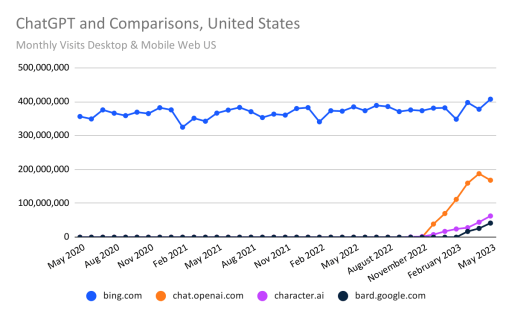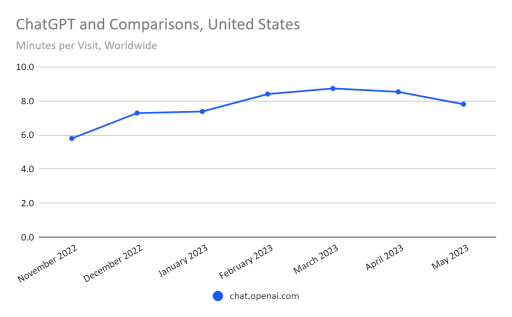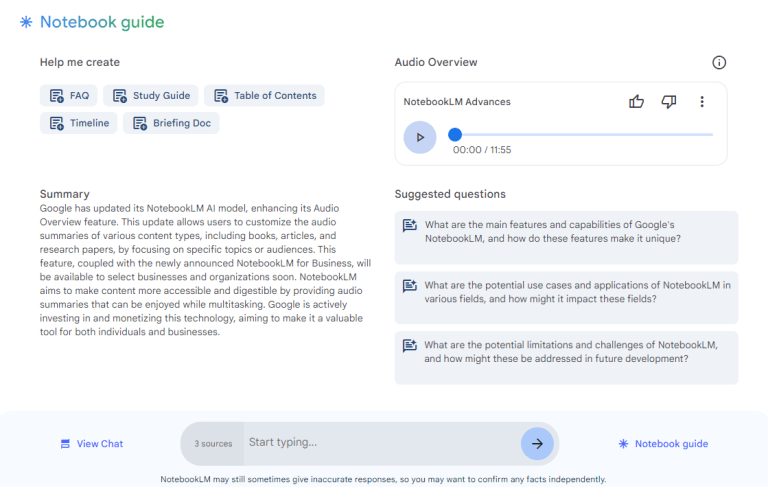ChatGPT Drops About 10% in Traffic as the Novelty Wears Off

Worldwide traffic dropped 9.7% and unique visitors were down 5.7% in June
ChatGPT no longer looks like it will keep growing until it’s the most-trafficked website in the world. In other words, Google is in no danger of being eclipsed by the OpenAI tech demo site that turned into a cultural phenomenon.
We reported last month that ChatGPT’s skyrocketing traffic growth was beginning to level out, but this is the first month it’s actually declined.
Key takeaways
- Worldwide desktop and mobile web traffic to the ChatGPT website, chat.openai.com, dropped 9.7% from May to June, according to preliminary estimates. In the U.S., the month-over-month decline was 10.3%.
- Worldwide unique visitors to ChatGPT’s website dropped 5.7%. The amount of time visitors spent on the website was also down 8.5%.
- ChatGPT still attracts more worldwide visitors than bing.com, Microsoft’s search engine, or Character.AI, the second most popular stand-alone AI chatbot site. Worldwide visits to Character.AI dropped 32% month-over-month, although traffic is still up tremendously from where it was in June 2022, when the company founded by ex-Google engineers was just getting started. Update: in subsequent research, we found that app growth more than made up for Character AI’s loss of web traffic.
ChatGPT stops defying gravity
In June, traffic and engagement for ChatGPT finally began to retreat after months of dizzying growth.
ChatGPT’s growth within the US was never quite as extreme as it looked on a worldwide basis, but here again, traffic began to shrink in June.
ChatGPT and Character.AI
Another AI chatbot site that had seen a rapid rise in the past few months was Character.AI, a playful site that has chatbots take on the personalities of celebrities, historical figures, and fictional characters. The website began to grow much more rapidly after ChatGPT attracted much more attention to AI chatbots in general, but its traffic volume also fell in June.
Read more: ChatGPT Is More Famous, but Character.AI Wins on Engagement
Time Spent on the Decline
Visitor engagement with ChatGPT is also dropping by the measure of minutes per visit. We don’t yet have this metric for June, but it was already down 8.5% in May.
What does this mean for OpenAI?
Whether OpenAI management is brokenhearted about the dip in traffic is debatable. Initially launched as a technology demo, the ChatGPT website primarily serves as a loss leader generating sales leads for OpenAI, which makes its technology available for other companies to embed in their applications.
Meanwhile, OpenAI CEO has described the cost of operating the mostly free service as “eye-watering” – external estimates have pegged it at about $700,000 per day.
Microsoft is a major backer and has embedded OpenAI’s GPT-4 algorithm into the Bing chat service offered as part of the search engine. Unlike Bing, OpenAI isn’t necessarily set up to run a mass-market, ad-supported website. The main direct revenue ChatGPT earns is from subscriptions sold to those who want access to the latest and greatest version. Subscribers get GPT-4, for example, while free users get an older version. The sustainability of that as a business model is questionable, given that people can get GPT-4 for free as part of Bing.
More significantly, OpenAI provides API access to more customizable versions of its software to other technology companies and corporate enterprises. Traffic to the platform.openai.com developer’s website was up 3.1% from May to June.
Still, the drop in interest not only for ChatGPT but one of its key competitors is a sign that the novelty has worn off for AI chat. Chatbots will have to prove their worth, rather than taking it for granted, from here on out.
The Similarweb Insights & Communications team is available to pull additional or updated data on request for the news media (journalists are invited to write to press@similarweb.com). When citing our data, please reference Similarweb as the source and link back to the most relevant blog post or similarweb.com/blog/insights/.
Contact: For more information, please write to press@similarweb.com.
Disclaimer: All names, brands, trademarks, and registered trademarks are the property of their respective owners. The data, reports, and other materials provided or made available by Similarweb consist of or include estimated metrics and digital insights generated by Similarweb using its proprietary algorithms, based on information collected by Similarweb from multiple sources using its advanced data methodologies. Similarweb shall not be responsible for the accuracy of such data, reports, and materials and shall have no liability for any decision by any third party based in whole or in part on such data, reports, and materials.
Wondering what Similarweb can do for your business?
Give it a try or talk to our insights team — don’t worry, it’s free!










